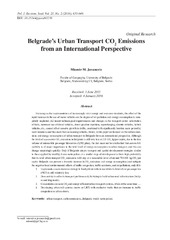Приказ основних података о документу
Belgrade's Urban Transport CO2 Emissions from an International Perspective
| dc.creator | Jovanović, Miomir | |
| dc.date.accessioned | 2021-09-24T15:35:01Z | |
| dc.date.available | 2021-09-24T15:35:01Z | |
| dc.date.issued | 2016 | |
| dc.identifier.issn | 1230-1485 | |
| dc.identifier.uri | https://gery.gef.bg.ac.rs/handle/123456789/767 | |
| dc.description.abstract | Focusing on the implementation of increasingly strict energy and emission standards, the effect of the rapid increase in the use of motor vehicles on the degree of air pollution and energy consumption is completely neglected. All recent technological improvements and changes in the transport sector: substitution of fuels, increased use of diesel vehicles, direct gasoline injection, supercharging, electric vehicles, hybrid vehicles, etc., cannot offset massive growth in traffic, combined with significantly heavier, more powerful, more luxurious and thus more fuel-consuming vehicles. Hence, in this paper we focused on the carbon emissions and energy consumption of urban transport in Belgrade from an international perspective. Although the level of automobile CO2 emissions in Belgrade is still very low at 228 CO2 kg/per capita, due to the low volume of automobile passenger kilometres (1,502 pkm), the fact must not be overlooked that automobile mobility is of major importance to the total level of energy consumption in urban transport, and this can change surprisingly quickly. Only if Belgrade adopts transport and spatial development strategies similar to those applied by wealthy Asian metropolises at a similar stage of development is there high probability that its total urban transport CO2 emissions will stop at a reasonable level of around 700-800 kg CO2/per capita. Belgrade can prevent a dramatic increase in CO2 emissions and energy consumption (and mitigate the negative local environmental effects of traffic congestion, traffic accidents, and air pollution), only if it: 1. Implements a more decisive strategy to limit private vehicle use while its level of car passenger km (PKT) is still relatively low. 2. Does not try to solve its transport problems only by trying to build urban road infrastructure (bridges and ring roads). 3. Concentrates on more CO2 and energy-efficient urban transport systems, while at the same time.. 4. Developing urban rail systems (metro or LRT) with exclusive tracks that are immune to traffic congestion on urban streets. | en |
| dc.publisher | Olsztyn : HARD Publishing Company | |
| dc.relation | info:eu-repo/grantAgreement/MESTD/Technological Development (TD or TR)/37010/RS// | |
| dc.rights | openAccess | |
| dc.source | Polish Journal of Environmental Studies | |
| dc.subject | urban transport | en |
| dc.subject | carbon emissions | en |
| dc.subject | Belgrade | en |
| dc.subject | world metropolises | en |
| dc.title | Belgrade's Urban Transport CO2 Emissions from an International Perspective | en |
| dc.type | article | |
| dc.rights.license | ARR | |
| dcterms.abstract | Јовановић, Миомир; | |
| dc.citation.volume | 25 | |
| dc.citation.issue | 2 | |
| dc.citation.spage | 635 | |
| dc.citation.epage | 646 | |
| dc.citation.other | 25(2): 635-646 | |
| dc.citation.rank | M23 | |
| dc.identifier.wos | 000373368300019 | |
| dc.identifier.doi | 10.15244/pjoes/61259 | |
| dc.identifier.scopus | 2-s2.0-84992488501 | |
| dc.identifier.fulltext | https://gery.gef.bg.ac.rs/bitstream/id/675/765.pdf | |
| dc.identifier.rcub | https://hdl.handle.net/21.15107/rcub_gery_767 | |
| dc.type.version | publishedVersion |


